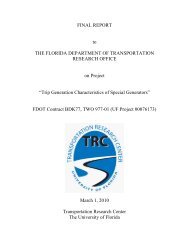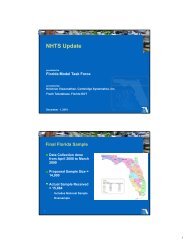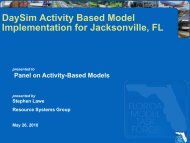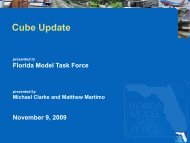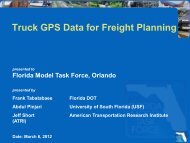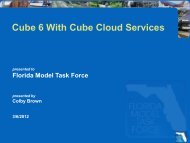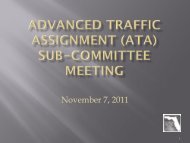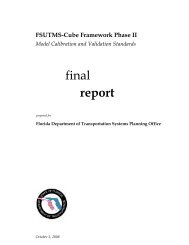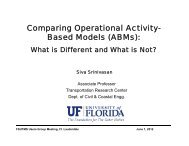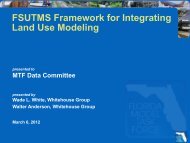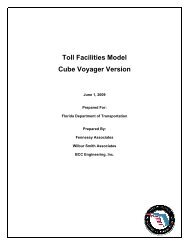Transit Modeling Guidance by Rosella Picado and ... - FSUTMSOnline
Transit Modeling Guidance by Rosella Picado and ... - FSUTMSOnline
Transit Modeling Guidance by Rosella Picado and ... - FSUTMSOnline
You also want an ePaper? Increase the reach of your titles
YUMPU automatically turns print PDFs into web optimized ePapers that Google loves.
<strong>Transit</strong> <strong>Modeling</strong> Update<br />
presented to<br />
MTF <strong>Transit</strong> & Rail Committee<br />
presented <strong>by</strong><br />
<strong>Rosella</strong> <strong>Picado</strong> <strong>and</strong> Bill Davidson, Parsons Brinckerhoff<br />
Matthew Martimo, Citilabs<br />
March 5, 2012
Objectives<br />
Improve the preparation of transit dem<strong>and</strong> forecasts in<br />
Florida to a point consistent with federal expectations<br />
Incorporate state of the practice techniques <strong>and</strong> tools in<br />
FSUTMS through a prototype model application
<strong>Transit</strong> Working Group<br />
Vidya Mysore, FDOT Systems Planning<br />
Vladimir Majano, FDOT Systems Planning<br />
Diana Fields, FDOT Systems Planning<br />
Diane Quigley, FDOT <strong>Transit</strong> Office<br />
Scott Seeburger, FDOT District 4<br />
Shi-Chiang Li, FDOT District 4<br />
Danny Lamb, FDOT District 7<br />
Larry Foutz, Miami-Dade MPO<br />
Dan Macmurphy, Traf-O-Data<br />
Jeannette Berk, Advanced Planning, Inc.<br />
Myung-Hak Sung, Gannett Fleming
Presentation Overview<br />
Project Overview<br />
PT Improvements<br />
Model Design <strong>and</strong> Development Guidelines<br />
• Auto Ownership <strong>and</strong> Trip Generation Model<br />
• Time of Day Segmentation<br />
• Trip Distribution Model<br />
• <strong>Transit</strong> Network Coding & Path Building<br />
• Mode Choice Model<br />
Prototype Application<br />
Concluding Remarks & Discussion
Project Overview<br />
On-Board Rider Survey – Synthesis of Practice<br />
Model Design & Development Guidelines<br />
Principles of Model Calibration <strong>and</strong> Validation<br />
Use of User Benefits Analysis Tools<br />
New Starts: Building a Case for the Project
On-Board Rider Survey Synthesis of Practice<br />
Underst<strong>and</strong>ing Markets<br />
Build on FTA Guidelines<br />
Topics<br />
• Fielding Surveys<br />
− Self Administered<br />
• Selected Data Items – Lessons Learned<br />
• Expansion Methodologies<br />
• Emerging Use of APC Data<br />
• File Manipulation & Preparation<br />
• Survey Assignment
Principles of Model Calibration <strong>and</strong> Validation<br />
<strong>Transit</strong> Travel Time Functions<br />
Upper Level Model Influences<br />
Model Assessment<br />
Model Calibration<br />
Forecasting Testing<br />
Documentation Recommendations
User Benefit Analysis Tools<br />
User Benefit Analysis Guidelines<br />
• Builds upon SUMMIT Program User’s Guide<br />
UserbenC Program<br />
Quality Control Guidelines & Procedures<br />
• Basic Quality Control Comparisons<br />
• St<strong>and</strong>ard SUMMIT Outputs<br />
• Underst<strong>and</strong>ing Service Level Changes<br />
• Capped Benefits<br />
• Underst<strong>and</strong>ing the Source of User Benefits<br />
• User Benefits per Project Trip
Case for the Project Workshop<br />
Pilot held in Miami – November 15 th <strong>and</strong> 16 th<br />
12 Sessions<br />
• Including 3 Mini-Workshops for Participants<br />
Framing the Benefits of the Project<br />
• Important Principles<br />
• Example Test Cases<br />
• Uncertainty Analysis<br />
• Defining the Problem<br />
• Implications for Practice<br />
Next Offering – May 2012 in Orl<strong>and</strong>o
<strong>Transit</strong> <strong>Modeling</strong> Update<br />
NEW PT FEATURES IN CUBE<br />
VOYAGER 6.0
New PT Features in Cube Voyager 6.0<br />
Enhanced Drive-Access Generation<br />
Enhanced Fares along with BestPathOnly<br />
Enhanced <strong>Transit</strong> Line Keywords<br />
11
Enhanced Drive-Access Generation<br />
Enhanced Drive-Access Generation<br />
Drive-Access Generation in 5.x<br />
Drive-Access Generation Examples in 5.x<br />
Drive-Access Generation in 6.x<br />
Enhanced Drive-Access Generation Example<br />
12
Examples of Drive-Access Coding<br />
Aerial photograph for parking lot & transit stops<br />
13
Examples of Drive-Access Coding<br />
Schematic diagram<br />
14
Examples of Drive-Access Coding<br />
Network with transit lines <strong>and</strong> non-transit access links<br />
15
Examples of Drive-Access Coding<br />
Example for kiss-ride facility with bus stop<br />
16
Drive-Access Generation in 5.x<br />
Historically Cube Voyager has been very strong in<br />
allowing users to automatically generate PT access<br />
connectors.<br />
The user was able to consider many factors including:<br />
17
18<br />
Drive-Access Generation in 5.x
Drive-Access Generation Examples in 5.x<br />
Potential GENERATE keyword values<br />
19
Drive-Access Generation Examples in 5.x<br />
Direct drive-access connection without parking nodes<br />
20
Drive-Access Generation Examples in 5.x<br />
Using ACCESSLINK with GENERATE<br />
• Optional keyword that provides a link connection from the parkride<br />
facilities to stop nodes<br />
• An access link is specified as ACCESSLINK = A-S, cost, distance<br />
where:<br />
−<br />
−<br />
−<br />
−<br />
A–Surrogate access point<br />
S–Stop node<br />
Cost–cost of using the access link<br />
Distance–distance traveled on the access link<br />
• TONODE is ignored <strong>and</strong> the connectors are generated to the stop<br />
node S<br />
• If the accesslink does not exist in the network, PT generates it<br />
21
Drive-Access Generation Examples in 5.x<br />
Drive-access connection with parking nodes<br />
22
Drive-Access Generation in 6.x<br />
Cube Voyager 6.0 has built upon the features of the<br />
existing Generate comm<strong>and</strong> to now consider:<br />
23
24<br />
Drive-Access Generation in 6.x
Enhanced Drive-Access Generation Example<br />
AUTOCON process in NERPM<br />
< Original Control > < PT Script ><br />
25
Output Files <strong>by</strong> PT AUTOCON Process<br />
Network with transit & non-transit links<br />
26
Output Files <strong>by</strong> PT AUTOCON Process<br />
Non-transit links (e.g. ‘PNRAUTOAM’ & ‘KNRAUTOAM’<br />
in original AUTOCON)<br />
Additional information for drive-access links (e.g.<br />
‘ACONLISTAM’ in original AUTOCON)<br />
27
Output Files <strong>by</strong> PT AUTOCON Process<br />
Report (e.g. ‘AUTOCONRPT’ in original AUTOCON<br />
28
Enhanced Fares along with BestPathOnly<br />
Fare Process in 5.x<br />
Enhanced Fare Process in 6.x<br />
29
Fare Process in 5.x<br />
Fares for PT modeling are generally evaluated after the<br />
routes have been built. This is because for many fare<br />
systems, the cost is not known until the complete route<br />
is known.<br />
Especially, the fares are not included into the<br />
generalized cost during enumerating/evaluating the<br />
routes with BestPathPath=T.<br />
30
Fare Process in 5.x<br />
Output example of route-evaluation process with<br />
BestPathOnly=T . Note that the route doesn’t<br />
include the fare in cost.<br />
31
Enhanced Fare Process in 6.x<br />
The user may specify a simple fare structure during<br />
while enumerating the routes to enhance the path<br />
building process.<br />
32<br />
Cube Voyager 6.0 includes additional fare keywords<br />
along with BestPathOnly:<br />
• ENUMFARE: if set to True, we allow a subset of fare systems<br />
to be considered in the best path enumeration process.<br />
• EVALFARE: if set to True, we allow fare to be calculated in the<br />
best path evaluation <strong>and</strong> skimming process.<br />
• EFARE: flag indicating whether to input descriptions of fare<br />
systems. If ENUMFARE=T <strong>and</strong> no fare skimming <strong>and</strong> route<br />
evaluation required, EFARE must be set to True to allow fares<br />
to be considered during the BESTPATHONLY route<br />
enumeration process.
Enhanced Fare Process in 6.x<br />
Example 1: Input fare settings for EVALFARE=T<br />
Example 1: Output report for EVALFARE=T<br />
33
Enhanced Fare Process in 6.x<br />
Example 2: Input fare settings for EVALFARE=T & ENUMFARE=T<br />
Example 2: Output report for EVALFARE=T & ENUMFARE=T<br />
34
Enhanced Fare Process in 6.x<br />
Example 3: Input fare settings for ENUMFARE=T &<br />
EFARE=T<br />
Example 3: Output report for ENUMFARE=T &<br />
EFARE=T<br />
35
Enhanced <strong>Transit</strong> Line Keywords in 6.x<br />
Cube Voyager’s PT program uses a series of keywords<br />
embedded in the description of the public transport line<br />
data to save information.<br />
36<br />
In order to provide better ways to calibrate <strong>and</strong> adjust<br />
transit travel times, some of the node specific keywords<br />
(specifically DWELL <strong>and</strong> DELAY) have also been made<br />
available as a line level keyword :<br />
• DWELL_DEFAULT: dwell time, in minutes, the line spends at<br />
all stop nodes for the line until one specifies a DWELL_C or<br />
DWELL sub-keyword.<br />
• DELAY_DEFAULT: additional time delay added to all link<br />
times for the line until one specifies a DELAY_C or DELAY<br />
sub-keyword.<br />
• TIMEFAC: time factor applied to the travel time of all links the<br />
line traverses.
Enhanced <strong>Transit</strong> Line Keywords in 6.x<br />
Example 1: <strong>Transit</strong> line setting using DWELL_DEFAULT<br />
Example 1: Comparison of run times in link level<br />
37
Enhanced <strong>Transit</strong> Line Keywords in 6.x<br />
Example 1: Comparison of run times in transit line<br />
(‘B6 EB’)<br />
38
Enhanced <strong>Transit</strong> Line Keywords in 6.x<br />
Example 2: <strong>Transit</strong> line setting using DELAY_DEFAULT<br />
Example 2: Comparison of run times in link level<br />
39
Enhanced <strong>Transit</strong> Line Keywords in 6.x<br />
Example 2: Comparison of run times in transit line<br />
(‘B6 EB’)<br />
40
Enhanced <strong>Transit</strong> Line Keywords in 6.x<br />
Example 3: <strong>Transit</strong> line setting using TIMEFAC<br />
Example 3: Comparison of run times in link level<br />
41
Enhanced <strong>Transit</strong> Line Keywords in 6.x<br />
Example 3: Comparison of run times in transit line (‘B6<br />
EB’)<br />
42
<strong>Transit</strong> <strong>Modeling</strong> Update<br />
TRIP MARKET<br />
SEGMENTATION
Key Travel Market Attributes<br />
Trip Purpose<br />
Current<br />
Proposed<br />
Home-Based Work<br />
Home-Based Work<br />
Home-Based Shop<br />
Home-Based Social/Recreation<br />
Home-Based Other<br />
Home-Based Shop<br />
Home-Based Social/Recreation<br />
Home-Based Other<br />
Home-Based College/University<br />
Home-Based School<br />
Non-Home-Based<br />
Non-Home-Based Work<br />
Non-Home Based Other
Proposed New Trip Purposes<br />
HB College/University<br />
• An important transit market in some regions<br />
• Comprised of several different subpopulations, each with<br />
distinct travel behavior characteristics<br />
• Well-identified destinations, less information available<br />
about place of residence<br />
• Mode split related to residence type, proximity to campus,<br />
transportation options
Proposed New Trip Purposes<br />
HB School<br />
• May comprise a large fraction of the transit riders in some<br />
cities<br />
• Possibly transit-dependent population<br />
• Often entitled to discounted fares<br />
• More likely observed on local buses<br />
• Short trips with distinct time-of-day patterns
Proposed New Trip Purposes<br />
NHB Work<br />
• Different diurnal patterns <strong>and</strong> transit mode shares than<br />
NHB Other<br />
• May comprise a large share of midday, downtown transit<br />
trips<br />
• May be forecasted with direct dem<strong>and</strong> models
Key Travel Market Attributes<br />
FSUTMS Household Markets<br />
Current<br />
Type of Dwelling Unit<br />
Household Size<br />
Auto Ownership<br />
Proposed<br />
Type of Dwelling Unit<br />
Household Size<br />
Auto Ownership<br />
Workers in Household<br />
Household Income
Key Travel Market Attributes<br />
Model Step<br />
Household<br />
Attribute<br />
Trip<br />
Generation<br />
Trip<br />
Distribution<br />
Mode<br />
Choice<br />
Housing unit type<br />
Income<br />
Workers<br />
Size<br />
? ?<br />
Auto ownership<br />
Car Sufficiency
Key Travel Market Attributes<br />
Home-Based Work Car Competition<br />
Zero car households<br />
Car insufficient households: fewer workers than autos<br />
Car sufficient households: equal or more workers than autos<br />
Home-Based Non-Work Car Competition<br />
Zero car households<br />
Car insufficient households: 1 auto, 2+ persons<br />
1 auto, 1 person<br />
Car sufficient households:<br />
1+ autos, 2+ persons
Key Travel Market Attributes<br />
FTA Recommended Mode Choice Stratification<br />
Zero Cars<br />
Car<br />
Insufficient<br />
Car<br />
Sufficient<br />
Low Income<br />
Medium Income<br />
High Income
Building the Household Classification<br />
Number of proposed household strata is too large to obtain<br />
directly from observed data for each TAZ<br />
• Housing unit type (2)<br />
• Income (3)<br />
• Workers (4)<br />
• Size (4)<br />
• Autos (4)<br />
2 x 3 x 4 x 4 x 4 = 384 Strata!<br />
Proposed method is to apply household classification models<br />
combined with an auto ownership model
Building the Household Classification<br />
Desired outcome:<br />
number of households in each feasible combination,<br />
for each TAZ<br />
Income 1<br />
Income 2<br />
W0<br />
Income 3<br />
W0<br />
S1 S2 S3 S4+<br />
S1 S2 S3 S4+<br />
S1 S2 S3 S4+<br />
W0 2 1 1 0<br />
W1 4 2 1 1<br />
W2 - 7 5 3<br />
W3+ - - 2 1
Building the Household Classification<br />
Start with a regional distribution of households (seed)<br />
Find, for each TAZ, the marginal distributions:<br />
• Number of 1p, 2p, 3p, 4p+ households<br />
• Number of 0w, 1w, 2w, 3+w households<br />
• Number of low inc, med inc, high inc households<br />
Apply Iterative Proportional Fitting (IPF) to fit the seed<br />
distributions to the marginal distributions
Building the Household Classification<br />
100%<br />
Marginal distributions<br />
may be developed with a<br />
classification model,<br />
Or they can be prepared<br />
as a model input<br />
Percent of Households<br />
90%<br />
80%<br />
70%<br />
60%<br />
50%<br />
40%<br />
30%<br />
1-Person<br />
2-Person<br />
3-Person<br />
4+-Person<br />
User-specified option<br />
20%<br />
10%<br />
0%<br />
1.00 1.50 2.00 2.50 3.00 3.50 4.00 4.50<br />
Average Household Size
Household size classification model<br />
100%<br />
90%<br />
80%<br />
70%<br />
Fraction of Households<br />
60%<br />
50%<br />
40%<br />
30%<br />
1-Person HH<br />
2-Person HH<br />
3-Person HH<br />
4-Person+ HH<br />
20%<br />
10%<br />
0%<br />
1.00 1.50 2.00 2.50 3.00 3.50 4.00 4.50 5.00<br />
Average Household Size<br />
Source data: Florida 2008 NHTS Add-On Sample
Household Workers Classification Model<br />
100%<br />
90%<br />
80%<br />
Percentage of Households<br />
70%<br />
60%<br />
50%<br />
40%<br />
30%<br />
0 Worker<br />
1 Worker<br />
2 Workers<br />
3+ Worker<br />
20%<br />
10%<br />
0%<br />
0.0<br />
0.1<br />
0.2<br />
0.3<br />
0.4<br />
0.5<br />
0.6<br />
0.7<br />
0.8<br />
0.9<br />
1.0<br />
1.1<br />
1.2<br />
1.3<br />
1.4<br />
1.5<br />
1.6<br />
1.7<br />
1.8<br />
1.9<br />
2.0<br />
2.1<br />
2.2<br />
2.3<br />
2.4<br />
2.5<br />
2.6<br />
2.7<br />
2.8<br />
2.9<br />
3.0<br />
3.1<br />
3.2<br />
3.3<br />
3.4<br />
3.5<br />
3.6<br />
3.7<br />
3.8<br />
3.9<br />
4.0<br />
Workers per Household<br />
Source data: Florida 2008 NHTS Add-On Sample
Household Income Classification Model<br />
100%<br />
90%<br />
80%<br />
70%<br />
Percent of Households<br />
60%<br />
50%<br />
40%<br />
30%<br />
Income 1<br />
Income 2<br />
Income 3<br />
Income 4<br />
20%<br />
10%<br />
0%<br />
0.0<br />
0.1<br />
0.2<br />
0.3<br />
0.4<br />
0.5<br />
0.6<br />
0.7<br />
0.8<br />
0.9<br />
1.0<br />
1.1<br />
1.2<br />
1.3<br />
1.4<br />
1.5<br />
1.6<br />
1.7<br />
1.8<br />
1.9<br />
2.0<br />
2.1<br />
2.2<br />
2.3<br />
2.4<br />
2.5<br />
2.6<br />
2.7<br />
2.8<br />
2.9<br />
3.0<br />
3.1<br />
3.2<br />
3.3<br />
3.4<br />
3.5<br />
3.6<br />
Median Income Index<br />
Source Data: Florida 2008 NHTS Add-On Sample
<strong>Transit</strong> <strong>Modeling</strong> Update<br />
AUTO OWNERSHIP MODEL
Why an Auto Ownership Model?<br />
<strong>Transit</strong> <strong>and</strong> non-motorized accessibility matters. An<br />
auto ownership model can be sensitive to accessibility,<br />
while a classification model is not.<br />
Can be estimated <strong>and</strong> validated from readily available<br />
data.<br />
Several effects are measurable: household size,<br />
workers, income <strong>and</strong> type of housing unit are good<br />
predictors of auto ownership.<br />
Reduces the number of IPF dimensions, which helps the<br />
household classification model to converge more<br />
quickly.
Proposed Auto Ownership Model<br />
Multinomial logit<br />
Choice set: 0,1,2,3,4+ autos per household<br />
Explanatory variables:<br />
• Household size, income, workers<br />
• Type of housing unit<br />
• Household <strong>and</strong> employment density<br />
• <strong>Transit</strong> <strong>and</strong> non-motorized accessibility
Mixed Household / Employment Density<br />
Mixed<br />
Density<br />
⎡ Intersections ×<br />
= ln⎢<br />
⎣ Intersections +<br />
( a × Households) × ( b×<br />
Employment)<br />
( ) ( ) ⎥ ⎤<br />
a×<br />
Households + b×<br />
Employment ⎦<br />
Calculated as floating densities!!
Mixed Household / Employment Density<br />
Traditional zonal-based densities do not capture<br />
neighborhood effects as well as floating densities
<strong>Transit</strong> Accessibility to Employment<br />
<strong>Transit</strong><br />
logsum<br />
( − 0.025×<br />
travel time ln( ))<br />
= ln∑<br />
+ employment
Sample Auto Ownership Coefficients<br />
1 Car 2 Cars 3 Cars 4+ Cars<br />
Coeff. t-stat Coeff. t-stat Coeff. t-stat Coeff. t-stat<br />
Household Income<br />
Low -2.78 -6.7 -4.67 -11.2 -5.50 -12.8 -5.81 -12.4<br />
Medium -1.31 -3.1 -2.54 -6.0 -2.98 -7.0 -3.40 -7.7<br />
High -0.29 -0.7 -0.72 -1.6 -0.90 -2.0 -0.91 -2.0<br />
Household Size<br />
2 Person HH -- -- +2.02 +33.1 +1.99 +18.5 +1.68 +8.3<br />
3 Person HH -- -- +1.80 +22.5 +2.40 +19.7 +1.93 +8.8<br />
4+ Person HH -- -- +2.09 +27.7 +2.34 +19.5 +2.61 +12.6<br />
Workers in HH<br />
1 Worker HH +0.89 +10.6 +1.06 +11.0 +1.14 +9.2 +1.37 +6.4<br />
2 Workers HH +0.51 +3.6 +1.61 +11.0 +1.86 +11.2 +2.15 +8.9<br />
3+ Workers HH -- -- +0.76 +4.2 +2.72 +14.2 +3.65 +13.7<br />
Multi-Family<br />
Housing Unit<br />
-0.34 -4.0 -1.08 -11.8 -1.80 -15.7 -2.08 -11.6<br />
Mixed Density -0.0325 -1.4 -0.0534 -2.3 -0.0916 -3.7 -0.0733 -2.5<br />
Walk Accessibility -- -- -- -- -0.5760 -2.7 -1.4000 -2.8<br />
<strong>Transit</strong> Accessibility -0.0801 -7.9 -0.0927 -8.6 -0.0927 -8.6 -0.0927 -8.6
<strong>Transit</strong> <strong>Modeling</strong> Update<br />
TRIP PRODUCTION MODEL
Trip Production Model<br />
Home-Based Work Trip Rates<br />
Household Income<br />
Household<br />
Autos<br />
Number of Workers in Household<br />
Wrks0 Wrks1 Wrks2 Wrks3+<br />
$0-$24999<br />
0.000 1.000 1.783 3.500<br />
$25000-$49999 0.000 1.000 1.783 3.500<br />
Veh0<br />
$50000-$74999 0.000 1.000 1.783 3.500<br />
$75000+ 0.000 1.000 1.783 3.500<br />
$0-$24999<br />
0.000 1.085 2.272 4.389<br />
$25000-$49999 0.000 1.332 3.145 4.389<br />
Veh1<br />
$50000-$74999 0.000 1.145 2.172 4.389<br />
$75000+ 0.000 0.954 2.094 4.389<br />
$0-$24999<br />
0.000 1.581 2.974 4.102<br />
$25000-$49999 0.000 1.604 3.171 4.102<br />
Veh2<br />
$50000-$74999 0.000 1.572 2.863 4.102<br />
$75000+ 0.000 1.330 3.111 4.102<br />
$0-$24999<br />
0.000 1.595 3.130 5.075<br />
$25000-$49999 0.000 2.297 3.109 5.075<br />
Veh3+<br />
$50000-$74999 0.000 1.967 3.247 5.799<br />
$75000+ 0.000 1.551 3.119 5.799<br />
Data Source: Florida 2008 NHTS Add-On Sample
Trip Productions Model<br />
Home-Based Other Trip Rates<br />
Household Income<br />
Household<br />
Autos<br />
Household Size<br />
Size1 Size2 Size3 Size4+<br />
$0-$24999<br />
0.535 1.057 1.310 3.719<br />
$25000-$49999 0.535 1.057 1.310 3.719<br />
Veh0<br />
$50000-$74999 0.535 1.057 1.310 3.719<br />
$75000+ 0.535 1.057 1.310 3.719<br />
$0-$24999<br />
0.611 1.451 2.946 3.155<br />
$25000-$49999 0.577 1.581 2.542 3.155<br />
Veh1<br />
$50000-$74999 0.696 1.877 2.438 3.155<br />
$75000+ 0.936 2.011 4.455 3.155<br />
$0-$24999<br />
0.630 1.181 2.823 4.000<br />
$25000-$49999 0.717 1.368 2.168 4.151<br />
Veh2<br />
$50000-$74999 0.768 1.330 2.160 4.839<br />
$75000+ 1.277 1.605 2.772 4.989<br />
$0-$24999<br />
1.175 0.973 1.832 4.216<br />
$25000-$49999 1.175 1.310 2.375 4.563<br />
Veh3+<br />
$50000-$74999 1.175 1.443 2.347 4.285<br />
$75000+ 1.175 1.319 2.039 4.813<br />
Data Source: Florida 2008 NHTS Add-On Sample
<strong>Transit</strong> <strong>Modeling</strong> Update<br />
TRIP ATTRACTION MODEL
Trip Attraction Model Alternatives<br />
Logit share model<br />
• Estimates the share of workers in each income group, at<br />
place of work, as a function of type of employment<br />
• Requires CTPP place of work data - 2012<br />
Cross-classification model<br />
• Similar to a trip production model<br />
• Requires establishment survey
Trip Attraction Model<br />
Linear regression model<br />
• Attractions stratified <strong>by</strong> income<br />
Trip Rate Employment Multiplier<br />
Trip<br />
Purpose<br />
Common<br />
Trip Rate<br />
Industrial<br />
Employment<br />
Service<br />
Employment<br />
Commercial<br />
Employment<br />
HBW Inc1 0.0910 0.728 1.000 2.437<br />
HBW Inc2 0.1943 2.452 1.000 1.874<br />
HBW Inc3 0.1932 0.754 1.000 1.325<br />
HBW Inc4 0.4225 1.231 1.000 0.741
Trip Attraction Model<br />
Trip attraction models are optional when the distribution<br />
model is a destination choice model<br />
The destination choice “size term” replaces the<br />
attraction model
<strong>Transit</strong> <strong>Modeling</strong> Update<br />
SPECIAL TRIP MARKETS
Special Trip Markets<br />
Seasonal Residents<br />
Visitors<br />
External Workers<br />
Air Passengers<br />
Other Special Generators<br />
Special Events
Example 1: Portl<strong>and</strong> Air Passenger Trip Model<br />
Air Passengers <strong>by</strong> Hour<br />
Resident / Personal<br />
Resident / Business<br />
Internal<br />
External<br />
Internal<br />
External<br />
Internal<br />
Trips<br />
Portl<strong>and</strong> Ground Access<br />
Mode Choice<br />
Visitor / Personal<br />
Internal<br />
External<br />
External<br />
Trips<br />
Residents<br />
Only<br />
Choice<br />
Visitors<br />
Only<br />
Visitor / Business<br />
Internal<br />
External<br />
Private<br />
Vehicle<br />
Taxi/<br />
Limo<br />
Hotel<br />
Shuttle<br />
Rental<br />
Car<br />
LRT<br />
Portl<strong>and</strong> Ground Access<br />
Air Trip Generation<br />
Drive<br />
<strong>and</strong> Park<br />
Pick-up /<br />
Drop-Off<br />
Drive<br />
Walk<br />
Garage<br />
Long-<br />
Term<br />
Economy Off-Site Garage<br />
/Escort<br />
Curb
Example 2: Phoenix Event Model<br />
Trip Origin Choice Set<br />
TAZ 1 TAZ 2 TAZ 3 TAZ n<br />
Event Mode Choice<br />
Event<br />
Location<br />
Choice Set<br />
for each<br />
Event<br />
Event “Reverse” Destination<br />
Choice Model<br />
Auto<br />
Walk<br />
Walk to<br />
<strong>Transit</strong><br />
Drive to<br />
<strong>Transit</strong><br />
Bus<br />
Bus &<br />
LRT<br />
LRT
<strong>Transit</strong> <strong>Modeling</strong> Update<br />
TIME OF DAY<br />
STRATIFICATION
Why Time of Day Stratification?<br />
Account for <strong>and</strong> represent time-of-day differences in transit<br />
levels of service:<br />
• frequency of service<br />
• fare<br />
• speed<br />
• routing<br />
Account for differences in travel markets:<br />
• peak period commute market<br />
• midday circulation market<br />
• off-peak period market(s)
FSUTMS Approach to Time of Day Effects<br />
Trip Generation<br />
(Daily)<br />
Trip Distribution<br />
(Daily)<br />
Based on free-flow<br />
travel times<br />
No travel time feedback<br />
Highway<br />
Assignment<br />
(Daily)<br />
Highway<br />
Pre-Assignment<br />
(Daily)<br />
Mode Choice<br />
(PK/OP)<br />
Peak travel times based on<br />
average daily conditions (HBW)<br />
Off-Peak travel times based<br />
on free-flow conditions<br />
<strong>Transit</strong><br />
Assignment<br />
(PK/OP)
Recommended Approach<br />
Initial<br />
speeds<br />
Trip Generation<br />
(Daily)<br />
Peaking Factors<br />
Trip Distribution<br />
(PK/OP)<br />
Mode Choice<br />
(PK/OP)<br />
AM <strong>and</strong> MD<br />
travel time<br />
feedback<br />
Diurnal & PA/OD<br />
Factors<br />
<strong>Transit</strong><br />
Assignment<br />
(PK/OP)<br />
Highway<br />
Assignment<br />
(AM/PM/MD/NT)
Implications for other model components<br />
Modifies the definition of peak <strong>and</strong> off-peak times<br />
• Peak conditions –AM peak, PM peak, mixed?<br />
• Off-peak conditions – assume midday (not free-flow)<br />
Requires period-specific networks:<br />
• <strong>Transit</strong> – peak & midday service levels<br />
• Highway -- AM / MD / PM / NT capacity factors<br />
True diurnal stratification of trip distribution <strong>and</strong> mode<br />
choice models<br />
Requires performing more highway assignments<br />
• More time periods<br />
• More feedback loops
Time of Day Periods<br />
Allow for region-specific definitions of the peak period<br />
• Longer peak periods observed in urban areas<br />
Define periods on the basis of:<br />
• Observed diurnal patterns (surveys, traffic counts)<br />
• <strong>Transit</strong> levels of service<br />
• Levels of congestion (today)<br />
• Levels of congestion (future) – leave room for peak<br />
spreading
FSUTMS Diurnal Factors<br />
Developed from 2008 NHTS Add-On data, for these<br />
periods:<br />
• AM Peak: 7:00 AM to 8:59 AM<br />
• Midday: 9:00 AM to 2:59 PM<br />
• PM Peak: 3:00 PM to 5:59 PM<br />
• Night: 6:00 PM to 6:59 AM<br />
Stratified <strong>by</strong> trip purpose (st<strong>and</strong>ard practice)<br />
Also stratified <strong>by</strong> household income <strong>and</strong> region
HBW Peaking & Diurnal Factors<br />
HBW Peak Factors<br />
CRTPA<br />
Period Region Florida<br />
Peak 0.773 0.420<br />
Off-Peak 0.227 0.580<br />
1.000 1.000<br />
HBW Diurnal Factors<br />
CRTPA Florida<br />
Period P/A A/P P/A A/P<br />
AM 0.418 0.000 0.354 0.004<br />
MD 0.108 0.039 0.106 0.065<br />
PM 0.031 0.325 0.034 0.294<br />
NT 0.046 0.033 0.053 0.090<br />
1.000 1.000<br />
Trip Frequency (%)<br />
18%<br />
16%<br />
14%<br />
12%<br />
10%<br />
8%<br />
6%<br />
4%<br />
2%<br />
0%<br />
Florida - From Home<br />
Florida - To Home<br />
CRTPA -From Home<br />
CRTPA - To Home<br />
1 3 5 7 9 11 13 15 17 19 21 23<br />
Time of Day (Hour)
Travel Time Feedback: Why?<br />
Ensure consistency of supply <strong>and</strong> dem<strong>and</strong> assumptions<br />
<strong>and</strong> outcomes in the forecast<br />
Travel Times derived<br />
from Link Flows<br />
Output from highway<br />
assignment<br />
=<br />
Travel Times that yield<br />
the assigned Trips<br />
Input to distribution<br />
& mode choice
Travel Time Feedback: How?<br />
Combine link volumes of previous feedback loops with a<br />
decreasing weight (to ensure convergence)<br />
Link Flow<br />
n+<br />
1<br />
= Link Flow<br />
n<br />
× (1−1 /<br />
n) + Link Flow<br />
n−1<br />
× (1 /<br />
n)<br />
Method of<br />
successive<br />
averages<br />
Compute new travel time <strong>by</strong> applying the speed-delay<br />
functions to the “averaged” volume<br />
Exit feedback loop when the relative change in link<br />
volumes <strong>and</strong>/or travel times is small
<strong>Transit</strong> <strong>Modeling</strong> Update<br />
TRIP DISTRIBUTION MODEL
Trip Distribution Model<br />
Proposed changes to FSUTMS discussed so far affect<br />
the specification <strong>and</strong> calibration of the distribution<br />
model:<br />
Levels of Service<br />
Household<br />
markets<br />
Input/output travel<br />
time consistency<br />
Model Structure<br />
Current<br />
Free-flow<br />
None<br />
No<br />
Gravity<br />
Proposed<br />
Peak<br />
Off-Peak<br />
Income &<br />
Car Sufficiency<br />
Yes<br />
Destination<br />
Choice
Destination Choice Advantages<br />
Sensitive to changes in highway <strong>and</strong> transit levels of<br />
service commensurate with their share of the travel<br />
market.<br />
• No more illogical changes to transit or auto trips!<br />
• e.g., when total person trips between two zones increase<br />
because of better travel times, the additional dem<strong>and</strong> is<br />
allocated to the improved modes.<br />
• Total person trips respond to changes in transit or nonmotorized<br />
accessibilities
Destination Choice Advantages<br />
Very flexible model form<br />
• Can accommodate multi-modal impedances <strong>and</strong> many<br />
other variables<br />
• Allows generic <strong>and</strong> market-specific variables, which result<br />
in parsimonious specifications that capture key market<br />
differences<br />
• Can be calibrated to match observed trip length<br />
frequencies <strong>and</strong> other calibration measures<br />
• Could even be used to apply the current gravity models!
Destination Choice Model<br />
Multinomial logit formulation<br />
choice<br />
Zone 1 Zone 2 Zone 3 …<br />
Zone N<br />
choice set contains all TAZs in the region<br />
Utility:<br />
U<br />
ijm<br />
=<br />
k k<br />
n<br />
∑ β × X + ln∑ γ ×<br />
ij<br />
k<br />
m<br />
S<br />
m<br />
j<br />
“quality” variables:<br />
travel time, travel distance, etc.<br />
“quantity” variables<br />
employment, households
Utility Function Variables<br />
Mode choice<br />
logsum<br />
• Impedance measure<br />
• Considers travel times, costs <strong>and</strong> preferences for all<br />
modes<br />
Distance<br />
• Used to reproduce observed trip length frequencies<br />
Trip market<br />
attributes<br />
Location<br />
attributes<br />
Size terms<br />
• Provide additional sensitivity to attributes such as<br />
urban form or household income<br />
• May be interacted with one or more distance terms<br />
• Represent barriers to travel, natural or perceived<br />
• Conceptually equivalent to a bridge time penalty<br />
• Represent activity opportunities at the destination<br />
• Often times consists of a weighted sum of<br />
employment <strong>by</strong> industry
Trip Market Stratification<br />
At least as many market segments as required <strong>by</strong> the<br />
mode choice model:<br />
• Trip purpose<br />
• Time period (peak & off-peak)<br />
• Household income & Car sufficiency<br />
Full segmentation is not required - some parameters are<br />
common across market segments<br />
Market segmentation helps to get the right workers to<br />
the right jobs, <strong>and</strong> exposes trips to accessibilities<br />
consistent with mode choice
Attraction Balancing<br />
The home-based work model is constrained so that<br />
attractions are proportional to employment at the<br />
destination zone<br />
A shadow price is added to each destination zone to<br />
increase or decrease its attractiveness<br />
U = U +<br />
'<br />
ijm<br />
ijm<br />
sp<br />
j<br />
The HBW destination choice model is applied iteratively<br />
until the shadow price, sp j , converges<br />
sp<br />
n+<br />
1<br />
j<br />
n ⎛<br />
= sp<br />
j<br />
+ ln⎜α<br />
Emp<br />
j ∑T<br />
⎝<br />
i<br />
n<br />
ij<br />
⎞<br />
⎟<br />
⎠
Attraction Balancing<br />
Whether to shadow price hinges on the level of<br />
confidence in the attractions forecast<br />
• Usually not very high confidence, except for HBW<br />
Recommended approach is to only constrain the HBW<br />
trips<br />
• Zonal employment is known<br />
• Compute shadow price for all household & car sufficiency<br />
segments combined.
Specifying a Destination Choice Model<br />
Unlike a gravity model, that only requires calibration, a<br />
destination choice model has parameters that need to<br />
be specified<br />
Model parameters are specified via model estimation<br />
<strong>and</strong> model calibration<br />
Some parameters may be transferred, but others must at<br />
least be calibrated
Destination Choice Estimation<br />
Requires commercially-available econometric software<br />
(Alogit, Biogene, Stata, etc.),<br />
… a sample of trip records from NHTS or local<br />
household travel survey:<br />
• Trip Id<br />
• Trip purpose<br />
• Production zone<br />
• Attraction zone (choice)<br />
• Household income (& other trip or hh. variables)<br />
… employment data, skims, <strong>and</strong> mode choice logsums
Destination Choice Estimation<br />
Sample the region’s zones to construct the destination<br />
choice set for each trip record<br />
Attach logsum, distance <strong>and</strong> employment information to<br />
each zone in the destination choice set
Destination Choice Estimation<br />
Sampling-<strong>by</strong>-importance:<br />
• Define an ‘importance’ function:<br />
W = exp( D ) × S<br />
P<br />
ij<br />
ij<br />
=<br />
W<br />
∑<br />
j<br />
ij<br />
W<br />
ij<br />
−α<br />
ij<br />
j<br />
• Importance function gives the probability of being selected<br />
as the destination zone<br />
• Sample from this probability distribution to select the<br />
destination choice set (20 – 40 draws) for each observed<br />
trip record
Destination Choice Estimation<br />
Optionally, explode the sample<br />
• Reproduce each trip record k times, <strong>and</strong> choose a different<br />
destination set for each ‘exploded’ record<br />
Approximately statistically equivalent to choosing a<br />
destination set of 10 x k for each original trip record<br />
Apply weights (1/k) <strong>and</strong> sampling correction factor<br />
during estimation<br />
U = U + C<br />
''<br />
ijm<br />
ijm<br />
jm
Destination Choice Estimation<br />
Size variable coefficients may be estimated<br />
simultaneously, or pre-calculated<br />
Size variable pre-calculation options:<br />
• Use representative employment<br />
− HBW - total employment<br />
− HBSH - retail employment<br />
− HBU – college enrollment<br />
• Estimate coefficients using linear regression, similar to<br />
attraction model estimation<br />
• Tabulate workers <strong>by</strong> household income <strong>and</strong> industry<br />
(provides HBW income stratification)
Linking Destination & Mode Choice<br />
Choice<br />
TAZ 1 TAZ 2 TAZ 3 TAZ 4 TAZ 5 TAZ N<br />
destination<br />
choice<br />
DA SR TRN DA SR TRN<br />
implicit mode<br />
choice nest<br />
U<br />
ij<br />
= λ × L<br />
ij<br />
+<br />
∑<br />
k<br />
k<br />
β<br />
×<br />
X<br />
k<br />
ij<br />
+ ln<br />
∑<br />
m<br />
γ<br />
m<br />
S<br />
m<br />
j<br />
mode choice logsum<br />
nesting coefficient
Destination Choice<br />
The mode choice logsum coefficient (λ) affects the<br />
sensitivity of the distribution model to level-of-service<br />
attributes (time, cost, etc.)<br />
• When λ 1?
Destination Choice Calibration<br />
Normalized Trip Frequency<br />
Calibration consists of<br />
adjusting the distance<br />
term(s) coefficients<br />
Similar calibration<br />
measures as a gravity<br />
model<br />
8%<br />
7%<br />
6%<br />
5%<br />
4%<br />
3%<br />
2%<br />
1%<br />
0%<br />
Estimated/Observed Work Trip Flows <strong>by</strong> Origin <strong>and</strong> Destination District<br />
Destination<br />
Origin 1 2 3 4 5 6 7 8<br />
Row<br />
Totals<br />
1 1.1 0.5 1.0 0.6 0.2 0.0 0.0 0.0 1.0<br />
2 0.1 1.3 0.1 0.7 0.0 0.1 0.0 0.0 1.0<br />
3 1.3 1.1 1.0 1.2 0.4 0.3 0.2 0.0 1.0<br />
4 0.9 1.2 0.8 1.0 0.3 0.5 0.1 0.1 1.0<br />
5 1.3 1.0 1.4 1.1 0.9 1.4 0.0 0.2 1.0<br />
6 0.0 1.2 0.6 1.1 2.6 1.0 0.4 0.4 1.0<br />
7 0.4 1.7 0.7 2.1 0.0 1.0 0.8 1.0 1.0<br />
Observed Avg = 12.6 mi 8 0.0 0.4 0.0 0.8 0.7 0.8 0.7 1.1 1.0<br />
Model Avg = 12.8 mi Total 1.2 1.3 0.9 1.0 0.7 0.7 0.7 0.8 1.0<br />
0 5 10 15 20 25 30 35 40 45 50<br />
Trip Distance (mi)
<strong>Transit</strong> <strong>Modeling</strong> Update<br />
TRANSIT NETWORK CODING<br />
AND PATH BUILDING
Many good practices already applied …<br />
Route <strong>and</strong> Stop/Station Location<br />
Follows actual routing <strong>and</strong> exact stop location as<br />
accurately as allowed <strong>by</strong> the model’s<br />
representation of the highway system.<br />
Recommend using transit agencies electronic<br />
records to obtain stop (lat, long) coordinates.<br />
Improves estimation of in-vehicle travel times,<br />
walk distances <strong>and</strong> transfer opportunities<br />
Applies faithful station coding (station micro-coding)<br />
Faithfully represents street-to-station, PNR-to-station,<br />
platform-to-platform separation (horizontal & vertical).
Good transit coding practices …<br />
Route attributes: Mode<br />
Defined on the basis of differences in<br />
operating characteristics <strong>and</strong><br />
attributes not included in the model<br />
(reliability, comfort, etc.).<br />
Can be more detailed than required<br />
<strong>by</strong> the mode choice model<br />
Used to create in-vehicle time skims<br />
FSUTMS <strong>Transit</strong> Modes<br />
Local Bus<br />
Premium Bus<br />
Circulators<br />
(Skyway <strong>and</strong> Trolley)<br />
Urban Rail<br />
Commuter Rail<br />
Other<br />
Project<br />
Additional <strong>Transit</strong> Mode<br />
Bus Rapid <strong>Transit</strong>
Good transit coding practices …<br />
Route attributes: Fare & Operator<br />
Applies the prevalent fare system(s)<br />
as faithfully as possible.<br />
Each fare system is assigned a<br />
unique operator code<br />
A given transit agency may be<br />
given more than one operator code,<br />
<strong>and</strong> conversely multiple transit<br />
agencies may share the operator code<br />
Coded fare represents average fare<br />
cost per boarding or transfer<br />
FSUTMS Operators<br />
Local Service<br />
Circulator<br />
Commuter Rail<br />
Revised Operators?<br />
Local Service<br />
Premium Service<br />
Circulator<br />
BRT<br />
Urban Rail<br />
Commuter Rail<br />
Other<br />
Project
Good transit coding practices …<br />
Route attributes: Headway <strong>and</strong> Wait Time<br />
Compute time-period representative headways<br />
May require coding ‘short routes’ separately from regular runs<br />
Compute wait time as ½ of the headway<br />
Remove current 30 minute cap<br />
Cap makes the model insensitive to<br />
some headway improvements<br />
In mode choice model, apply lower<br />
weight to first wait times higher than 5<br />
minutes, in recognition that arrivals are<br />
not r<strong>and</strong>om
<strong>Transit</strong> network coding<br />
<strong>Transit</strong> speed<br />
Mode Current Method Proposed Method<br />
Fixed-guideway<br />
Buses<br />
Coded station-to-station<br />
travel time<br />
Proportional to auto<br />
travel time<br />
(same)<br />
Auto travel time +<br />
delay per stop
<strong>Transit</strong> network coding<br />
Access Connectors<br />
Connector generation<br />
Generalized cost<br />
components<br />
Access time<br />
Walk Access<br />
Shortest distance<br />
from TAZ to stop<br />
Based on highway distance <strong>and</strong><br />
assumed walk speed<br />
Drive Access<br />
Generalized cost<br />
from TAZ to PNR/KNR node<br />
Drive time, terminal time<br />
operating cost, parking cost<br />
Based on volume-dependent<br />
travel times<br />
Maximum length 0.6 miles 3.0 miles, lot specific<br />
Maximum<br />
connections<br />
99 per TAZ 3 per TAZ<br />
May not be long enough,<br />
depending on average<br />
TAZ size <strong>and</strong> local<br />
behavior
<strong>Transit</strong> network coding<br />
Access Connectors: REWALK program<br />
Proceed with caution; unclear whether REWALK may have un-intended<br />
consequences (gains/loses in coverage unrelated to the project)<br />
Useful network coding diagnostic tool<br />
If the following condition exists,<br />
No connectors were generated<br />
No transit stop at centroid connectors, % walk < 95%<br />
No transit stop at centroid connector, % walk greater than or<br />
equal to 95% <strong>and</strong> shortest connector is less than ½ mi.<br />
No transit stop at centroid connector, % walk greater than or<br />
equal to 95% <strong>and</strong> shortest connector greater than ½ mi.<br />
<strong>Transit</strong> stop(s) at centroid connector <strong>and</strong> zone is 100% walk<br />
<strong>Transit</strong> stop(s) at centroid connector <strong>and</strong> % walk is between<br />
minimum threshold <strong>and</strong> 100%<br />
<strong>Transit</strong> stop(s) at centroid connector <strong>and</strong> % walk is less than<br />
minimum threshold<br />
Then:<br />
Reset % walk to zero<br />
Reset all % walks to zero <strong>and</strong> delete all<br />
connectors<br />
None (CBD exception)<br />
Reset all % walks to zero <strong>and</strong> delete all<br />
connectors<br />
None<br />
Adjust all connector times to ½ mile walk<br />
Reset all % walks to zero <strong>and</strong> delete all<br />
connectors
Path building <strong>and</strong> skimming<br />
Path Building Weights – Tier B Cities<br />
FSUTMS<br />
Recommended<br />
Path Attribute Local Bus Project Local Bus Project<br />
Walk access time 2.0 2.0 2.0 2.0<br />
Drive access time 1.0 1.0 1.0 1.0<br />
All walk time 10 10 - -<br />
Transfer walk time 2.0 2.0 2.0 2.0<br />
Initial <strong>and</strong> transfer wait 2.0 2.0 2.0 2.0<br />
Transfers 10 10 10 10<br />
Local Bus IVTT 1.0 1.3 1.0 1.1 – 1.2<br />
Premium Bus IVTT 10 1.0 - 1.0<br />
Circulator IVTT 1.0 1.3 1.0 1.1 – 1.2<br />
Urban Rail IVTT 10 1.0 - 1.0<br />
Commuter Rail IVTT 10 1.0 - 1.0<br />
Project IVTT 10 1.0 - 1.0
Path building <strong>and</strong> skimming<br />
Path Conditioning<br />
Removes irrelevant paths from the skim matrices:<br />
- all walk paths<br />
- paths that do not use relevant line-haul mode<br />
Recommendation:<br />
Implement logic directly in mode choice program
<strong>Transit</strong> <strong>Modeling</strong> Update<br />
MODE CHOICE MODEL
Trip market segmentation<br />
Walk Market Segmentation<br />
Recommendation: Implement short & long walk market segmentation<br />
Short walk: ¼ mile buffer around stops & stations<br />
Long walk: ½ mile buffer around stops <strong>and</strong> stations<br />
… or as established <strong>by</strong> analysis of on-board survey<br />
data<br />
Access<br />
Short Walk<br />
Egress<br />
Long Walk<br />
Short Walk 1 2<br />
Long Walk 3 4<br />
Drive 5 6<br />
No <strong>Transit</strong> 7
Trip market segmentation<br />
Household Market Segmentation<br />
FTA Recommended Mode Choice Stratification<br />
Zero Cars<br />
Car<br />
Insufficient<br />
Car<br />
Sufficient<br />
Low Income<br />
Medium Income<br />
High Income<br />
Time Period Segmentation<br />
Stratify all purposes <strong>by</strong> peak <strong>and</strong> off-peak periods
Tier A Mode Choice Nesting Structure
Tier B/C Cities Mode Choice Nesting Structure
Proposed Choice Set <strong>and</strong> Nesting Structure
FSUTMS Nesting Coefficients<br />
0.8 0.5<br />
Unequal scaling factors applied<br />
to auto <strong>and</strong> transit coefficients<br />
0.2 0.5
Nesting coefficient: what is it?<br />
A measure of the correlation between alternatives<br />
0 < µ < 1<br />
1 –µ ~ correlation<br />
Choice<br />
Auto<br />
<strong>Transit</strong><br />
Drive-<br />
Alone<br />
Shared-<br />
Ride<br />
Bus<br />
Light-Rail<br />
<strong>Transit</strong><br />
More elastic<br />
Less elastic<br />
More elastic
Nested Logit Model: How?<br />
Choice<br />
Auto<br />
<strong>Transit</strong><br />
Nest coefficient<br />
µ = 0.3<br />
Drive-<br />
Alone<br />
Shared-<br />
Ride<br />
Bus<br />
Light-Rail<br />
<strong>Transit</strong><br />
• Nesting coefficients scale the utilities: U N (bus) = U(bus) / µ<br />
• Nesting coefficients take values between 0 <strong>and</strong> 1<br />
• Steeper diversion curve between nested alternatives<br />
• Smaller the nesting coefficient, the more similar the nested alternatives<br />
• When µ = 1, the model becomes multinomial logit (MNL)<br />
• When µ
Logit Model Curve<br />
1<br />
Auto Probability<br />
0.9<br />
0.8<br />
0.7<br />
0.6<br />
0.5<br />
0.4<br />
0.3<br />
0.2<br />
0.1<br />
No Parking Cost<br />
Less<br />
Change<br />
Greater<br />
Change<br />
Paid Parking Cost<br />
0<br />
-5 -4 -3 -2 -1 0 1 2 3 4 5<br />
<strong>Transit</strong> Utility - Auto Utility
Logit Model Curve<br />
1<br />
Auto Probability<br />
0.9<br />
0.8<br />
0.7<br />
0.6<br />
0.5<br />
0.4<br />
0.3<br />
0.2<br />
0.1<br />
No Parking Cost<br />
Less<br />
correlated<br />
µ = 0.9<br />
More<br />
correlated<br />
µ = 0.3<br />
Paid Parking Cost<br />
0<br />
-5 -4 -3 -2 -1 0 1 2 3 4 5<br />
<strong>Transit</strong> Utility - Auto Utility
Proposed Nesting Coefficients<br />
0.7 0.7<br />
0.5 0.5
Coordinating DC <strong>and</strong> MC Calibration<br />
If confident of soundness of<br />
mode choice model, use<br />
logsums ‘as is’ for destination<br />
choice estimation<br />
calibrate<br />
Person Trips<br />
Destination<br />
Choice<br />
Mode<br />
Choice<br />
Logsums<br />
calibrate<br />
If confident of soundness of<br />
person trip tables, start <strong>by</strong><br />
calibrating mode choice
<strong>Transit</strong> <strong>Modeling</strong> Update<br />
PROTOTYPE APPLICATION
Trip Generation<br />
EE Trips<br />
Visitor &<br />
Seasonal<br />
Resident<br />
Trips<br />
Build Highway Network &<br />
Free-Flow Skims<br />
Current CRTPA<br />
Program Flow<br />
Permanent<br />
Resident<br />
Trips<br />
Trip Distribution<br />
Gravity<br />
Model<br />
Pre-<br />
Assignment<br />
Congested<br />
Skims<br />
Mode Choice<br />
<strong>Transit</strong> Model:<br />
Build <strong>Transit</strong> Network & Skims<br />
Trip Assignment<br />
Reporting
Build Hwy Networks & Skims<br />
Build Peak Trn Network & Skims<br />
Peak Factoring<br />
Trip Generation<br />
Demo CRTPA<br />
<strong>Transit</strong> Update<br />
Program Flow<br />
EE Trips<br />
HH<br />
Classification<br />
Auto<br />
Ownership<br />
Visitor &<br />
Seasonal<br />
Resident<br />
Trips<br />
Permanent<br />
Resident<br />
Trips<br />
<strong>Transit</strong> Model:<br />
Build <strong>Transit</strong> Network & Skims<br />
Mode Choice<br />
Logsums<br />
Trip Distribution<br />
Peak & Off-Peak Destination Choice<br />
Time of Day<br />
Factoring<br />
Mode Choice<br />
(apply probabilities)<br />
Highway<br />
Assignment<br />
Converged?<br />
NO<br />
Peak & Off-Peak<br />
Highway Skims<br />
YES<br />
<strong>Transit</strong><br />
Assignment<br />
Reporting
Build Hwy Networks & Skims<br />
Build Peak Trn Network & Skims<br />
Develop initial highway skims<br />
Trip Generation<br />
EE Trips<br />
Visitor &<br />
Seasonal<br />
Resident
Build Hwy Networks & Skims<br />
Build Peak Trn Network & Skims<br />
Develop initial transit skims<br />
Trip Generation<br />
EE Trips<br />
Visitor &<br />
Seasonal<br />
Resident
Trip Generation<br />
EE Trips<br />
HH<br />
Classification<br />
Visitor &<br />
Seasonal<br />
Resident<br />
Trips<br />
Household Classification Model<br />
Auto Ownership Model<br />
Updated Trip Generation Model<br />
Auto<br />
Ownership<br />
Permanent<br />
Resident<br />
Trips
Build Hwy Networks & Skims<br />
Build Peak Trn Network & Skims<br />
Peak | Off-Peak<br />
Peak Factoring<br />
Trip Generation<br />
EE Trips<br />
HH<br />
Classification<br />
Visitor &<br />
Seasonal<br />
Resident<br />
Trips<br />
<strong>Transit</strong> Model:<br />
Build <strong>Transit</strong> Network & Skims<br />
Auto<br />
Ownership<br />
Permanent<br />
Resident<br />
Trips<br />
Mode Choice<br />
Logsums<br />
Time of Day<br />
Stratification<br />
Trip Distribution<br />
AM | MD | PM | NT<br />
Peak & Off-Peak Destination Choice<br />
Time of Day<br />
Factoring<br />
Mode Choice<br />
(apply probabilities)<br />
Highway<br />
Assignment<br />
Converged?<br />
NO<br />
Peak & Off-Peak<br />
Highway Skims<br />
YES
Travel time feedback
Feedback loop control<br />
Model exits the travel time feedback loop when it<br />
reaches convergence or performs the maximum number<br />
of loops<br />
• Convergence is measured <strong>by</strong> travel time <strong>and</strong> link volume<br />
average percent change<br />
• Convergence threshold is a user-input<br />
• Maximum number of loops is a user input<br />
Successive averages are used to compute the feedback<br />
volumes
Trip Distribution<br />
Destination choice models replace the current gravity<br />
models<br />
Stratified <strong>by</strong> trip purpose, household market <strong>and</strong> time<br />
period<br />
Completely scripted in Cube/Voyager<br />
Parameter file includes “place-holders” to allow for<br />
more detailed specifications
Build Hwy Networks & Skims<br />
Build Peak Trn Network & Skims<br />
Peak Factoring<br />
Trip Generation<br />
EE Trips<br />
HH<br />
Classification<br />
Visitor &<br />
Seasonal<br />
Resident<br />
Trips<br />
<strong>Transit</strong> Model:<br />
Build <strong>Transit</strong> Network & Skims<br />
Auto<br />
Ownership<br />
Permanent<br />
Resident<br />
Trips<br />
Mode Choice<br />
Logsums<br />
Mode Choice<br />
Trip Distribution<br />
Peak & Off-Peak Destination Choice<br />
Time of Day<br />
Factoring<br />
Mode Choice<br />
(apply probabilities)<br />
Highway<br />
Assignment<br />
Converged?<br />
NO<br />
Peak & Off-Peak<br />
Highway Skims<br />
YES
Model Inputs: What’s New?<br />
Zonal Data<br />
Variable<br />
ACRES<br />
ST_CNTY<br />
RESDHHLD<br />
RESDPOP<br />
HHINCINDEX<br />
WRKRPHHLD<br />
UNV_ENROL<br />
Description<br />
Area of the TAZ (in acres).<br />
State/County code.<br />
Permanent resident households.<br />
Permanent resident population.<br />
Median household income index: ratio of the median<br />
household income of the TAZ to the median household<br />
income of the region.<br />
Average number of workers per household.<br />
Number of student enrolled at university <strong>and</strong> college<br />
institutions
Model Inputs: What’s New?<br />
Initial AM <strong>and</strong> MD person trip tables<br />
• For generating first loop peak <strong>and</strong> off-peak travel times<br />
• Derived from an existing model run<br />
Seed household classification table<br />
• Obtained from 2010 PUMS<br />
Percent walk file<br />
• Percent of a TAZ that has short <strong>and</strong> long walk access to<br />
transit (new to Tier A model)
Model Parameters: What’s New?<br />
Peaking factors & diurnal factors<br />
Household classification curves<br />
Updated trip production rates<br />
Destination choice parameters<br />
Updated mode choice nesting coefficients
Model Outputs: What’s New?<br />
Trip productions <strong>by</strong> trip purpose, revised household<br />
markets, <strong>and</strong> time of day split<br />
Person trips <strong>by</strong> trip purpose, revised household<br />
markets, <strong>and</strong> time of day split<br />
Auto trips <strong>by</strong> four time periods<br />
Loaded highway networks for four time periods
Catalog Keys: What’s New?<br />
Auto occupancy factors <strong>by</strong> trip purpose<br />
Highway capacity factors<br />
IPF control parameters (convergence & iterations)<br />
Travel time feedback control parameters<br />
Select zone – for debugging purposes
<strong>Transit</strong> <strong>Modeling</strong> Updates<br />
PROJECT DELIVERABLES
Deliverables<br />
Technical Memor<strong>and</strong>a<br />
• Trip Generation Review <strong>and</strong> Recommendations<br />
• Time of Day Stratification<br />
• Trip Distribution Review <strong>and</strong> Recommendations<br />
• Mode Choice Review <strong>and</strong> Recommendations<br />
• AUTOCON Development<br />
• Additional PT Functionality<br />
• On-Board Rider Survey Synthesis of Practice<br />
• Principles of Model Calibration <strong>and</strong> Validation<br />
• User Benefit Analysis Guidelines<br />
• Quality Control Guidelines
Deliverables<br />
Powerpoint Presentations<br />
• Trip Generation Review <strong>and</strong> Recommendations<br />
• Time of Day Stratification<br />
• Trip Distribution Review <strong>and</strong> Recommendations<br />
• Mode Choice Review <strong>and</strong> Recommendations<br />
• Logit Model Primer<br />
• User Benefits
Deliverables<br />
Workshops<br />
• Case for the Project – Miami Pilot<br />
Software & Applications<br />
• UserBenC<br />
• <strong>Transit</strong> Update Prototype Model<br />
• Additional PT functionality (Cube 6.0)



